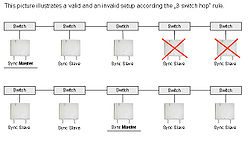HiPath Cordless IP - IEEE 1588
The Wiki of Unify contains information on clients and devices, communications systems and unified communications. - Unify GmbH & Co. KG is a Trademark Licensee of Siemens AG.
In DECT systems with a circuit-switched connection, e.g. HiPath Cordless Office systems, the synchronization information required to synchronize the base stations is derived from the UP0 connection. This is not possible in IP systems.
However, accurate time synchronization between the DECT IP base stations is vital for a seamless call handover.
Two methods of synchronization are provided by HiPath Cordless IP, both can be mixed in one system.
Contents
Synchronization via DECT (radio/air synchronization)
In order to synchronize with another DECT IP base station via the DECT interface, a DECT IP base station must be within the overlap area of the radio cell that forms this DECT IP base station. In addition, the DECT IP base station can be synchronized on other DECT IP base stations, which increases the availability of synchronicity in this cluster.
Synchronization via LAN
One DECT IP base station can be synchronised via LAN with other DECT IP base stations. This is done via the IEEE Standard Precision Time Protocol (PTP)
IEEE1588.
In difference to the HiPath Cordless IP synchronization over air, the Ethernet based synchronization mechanism (according IEE1588, PTP Precious Time Protocol) requires fewer configurations.
On the other hand, requirements are made on the Ethernet characteristics like loss, delay, jitter etc. Therefore special requirements regarding the Ethernet components (especially to the Ethernet switches) have to be considered. If these values (especially jitter) are bad Sync loses are likely.
When you want to use syncronization via LAN, a project specific release is needed. Please contact product management
Summary
The main advantages of synchronization via LAN are:
- more flexibility in the location of the DECT IP base station - no need to built synchronisation chains as with synchronisation via DECT,
- less DECT IP base stations are required, because the overlapped area of DECT IP base station is less,
- configuration of DECT IP systems is simplified, because all DECT IP base stations can be synchronised to only one synchronisation master
Basic requirement to the LAN to use synchronization via LAN
The HiPath Cordless IP base station which provides the Sync signal is called Sync Master, the HiPath Cordless IP base stations(s) which gets the Sync signal is called Sync Slave in the following. One Sync Master can provide the Sync signal to many (or even all) Sync Slaves.
A maximum number of three cascaded Ethernet switches are supported between the Sync Master and a Sync Slave. This means max. 3 switches (hops) between Sync Master and each Sync Slave (for instance: DECT IP base station with Sync Master -> (1) floor switch -> (2) building switch -> (3) floor switch -> DECT IP base station with Sync Slave)
Only enterprise grade switches are able to support these requirements (tested switches please see below).
Resynchronization
The DECT functionality of all DECT IP base station which is configured as Sync Slaves depends on the availability of the Sync Master. If the Sync Master is not functional (e.g. not online because of network problems) the DECT functionality of all Sync Slave BSIP goes down.
Other Configuration hints
In general are the IP network requirements also valid in this scenario (VoIP ready network, every DECT IP base station must be in a flat layer two network with the HiPath Cordless IP SW – which is either on one of the DECT IP base stations or one the DECT IP server).
The usage of a dedicated DECT VLAN is highly recommended, the CoS value of the DECT VLAN must be assigned to the highest priority in the network switch.
Asymmetric network topology (packet routing) will lead to asynchronous base stations. This will cause call drops.
Consideration of LAN Sync in a customer network
When you want to use syncronization via LAN, a project specific release is needed. Please contact product management
1.) the topology requirement of max. three cascaded switches between Sync Master and Sync Slaves is a must,
2.1.) if the customer use one of the following switches the usage of LAN Sync is possible the following switches are already tested and could be used:
- every 24-port PoE Layer2 switch from D-Link; e.g. - D-Link DES-1228P, DES-3028P, DGS-1224TP
- every 24-port PoE Layer2 switch from Hewlett Packard (HP ProCurve Series), e.g. - HP ProCurve 2626-PWR
- Enterasys Switch B3G124 (1Gbit)
- Enterasys Switch B5G124
- Cisco Catalyst 3560
- Cisco Catalyst 2960
- Cisco Small Business Pro ESW 500 (remark; all switch ports used for HiPath Cordless IP were configured as "others")
Remark: If the customer use Layer3 switches, the L3 function of the relevant switch ports have to be deactivated.
2.2.) if the customer does not use one of the above mentioned switches please provide the following information
- please use at least two HiPath Cordless IP base stations in the customer network, they should be in the maximum distance from each other (e.g. connected to different floor switches),
- please configure one of these base station as BSIP_IWU and the other one as BSIP_only,
- please administer the BSIP_only as IEEE1588 Sync Master and the BSIP_IWU as IEEE1588 Sync Slave,
- please Sync the BSIP_only which is configured as IEEE Sync Master via LAN to the other BSIP,
- please start the System,
- please make a copy of the IWU screen “Status” -> “Modules 1” and “Status” -> “Modules2” after they run app. 2 hours (please check if the entire content of the screens is part of this copy),
- please clear the statistic via the button “Clear Statistic” and make a second copy after additional 2h,
- please provide also the type of the connected switches and a little topology pictures
Please send these information to: product management
We will reply as soon as possible based on the delivered information.





